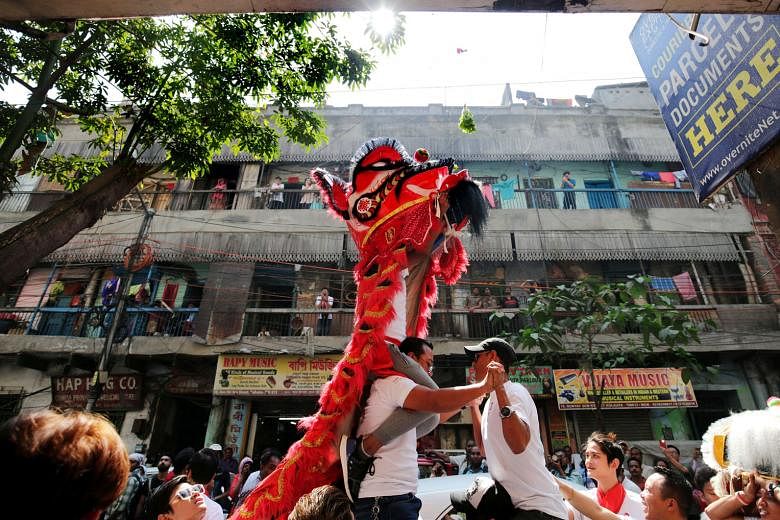The narrow alleys of Tangra in Kolkata wear a deserted look for most of the year, but come alive with fresh coats of red paint on doors and red lanterns strung along the streets during Chinese New Year celebrations.
The Year of the Dog was ushered in at 11.30pm on Thursday in the eastern Indian city, with lion dance troupes taking over the streets, surrounded by crowds.
The dancers, from the young to the elderly, took part in a parade and blessed every shop and house in return for red packets.
Each lion dance troupe went to more than 200 homes and shops.
"I feel the vibes are much better in Kolkata than in China (for Chinese New Year)," said Mr Fredrick Liao, 30, whose family owns popular Chinese restaurant Golden Joy.
"It is the biggest festival and lots of Chinese people who have gone overseas come back."
Ten of his family members have returned from different parts of the world, including Singapore, to celebrate the festive season.
"For the next week, there is a lot to do. We have a fete, lots of family gatherings and traditional Chinese meals," he said.
Some members of the community pray at the Chinese temple dedicated to Kali, the Hindu goddess believed to be the destroyer of evil.
Legend has it that the temple, which is built around a banyan tree, brings good luck.
"I pray to Ma (mother) Kali. I do puja (worship)," said Mr John Chen, a 65-year-old former tannery worker and caretaker of the temple.
Kolkata, which has a population of over 4.4 million, is home to the only Chinatown in India.
Tangra's sauce factory, a dozen or so Chinese restaurants, a small cemetery and shrines are the only giveaways that this is unlike any other place in India.
The Chinese community has shrunk to around 2,000 from 30,000 in the 1950s, with many migrating for studies and better work opportunities to countries like Canada, the United States, Britain and Sweden.
Most of those who have stayed find the going tough as tanneries, the former mainstay of the community, were moved out years ago.
Nearly two dozen Chinese restaurants compete for customers, while the only Chinese school in the area has been shut for years.
For some among the older generation, insecurity still remains, with memories of the 1962 Sino-Indian War lingering, when members of the community were interned by the suspicious Indian authorities.
However, those worries recede during Chinese New Year celebrations, as family and friends gather for the festivities.
Mr Charles Hsieh, who studied in the local Chinese school, has returned to Kolkata, where he was born and grew up, after 20 years away.
Mr Hsieh, who lives in Sweden, visited his father's grave, watched the lion dances and visited his former school.
"I missed Chinese New Year for 20 years. All the memories are coming back from when I was young.
"I couldn't recognise so many friends because everyone has grown old," he said.
An estimated 300 to 400 people who settled abroad have returned to Tangra for the festive period.
Members of Kolkata's Chinese population are mostly from the Hakka community in Guangdong province in China, as well as some Cantonese.
The first Chinese man in Kolkata was said to be Yang Tai Chow, also known as Tong Achi, who landed in 1778. He was said to have mistakenly sailed into the banks of Hooghly River and was granted land by the British to set up a sugar cane plantation and sugar factory.
To this day, a key Chinese New Year tradition is a visit to his shrine to light candles and incense sticks.
Ms Monica Liu, one of the community's most successful restaurateurs, will drive 33km to Achipur with family members on the second Sunday of the Chinese New Year to seek blessings.
"We will pay our respects to the first Chinese to come to Kolkata," said Ms Liu, who noted that the community still maintains many of the traditional Chinese practices.
Houses are cleaned and painted in advance , family feasts take place during the first two weeks and red packets containing money are given by the elders to younger people.
The first day of the Chinese New Year on Friday was observed by most in the community as a vegetarian day.
Still, many among the older generation worry that traditions are fading with every successive generation.
"We don't know what will happen next. At the moment, we as seniors keep our tradition alive," said Ms Liu, who speaks Hakka, Mandarin, Cantonese and Hindi.
She is relieved that the younger generation still gets excited about the lion dances.
"We try to let them understand and they do follow us (in keeping traditions)," she said. "But as for the future? We don't know."

